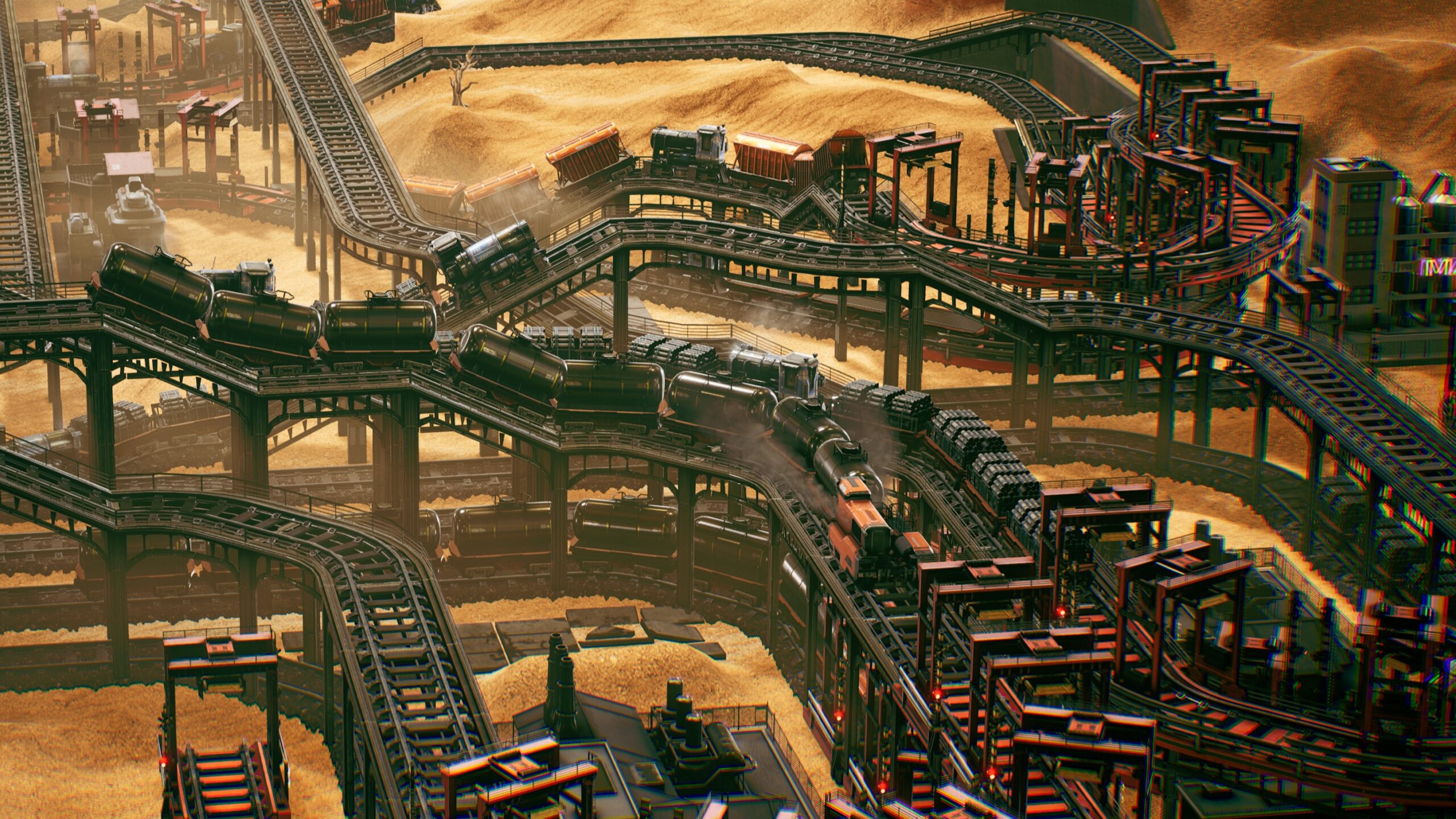Railgrade isn’t the game that its trailers and store page led me to expect, and it seems that I’m not alone, given a cursory glance at its user reviews on Steam. Like so many others, I went into this railway management sim expecting something similar to Transport Tycoon, or perhaps an automation-style game in the vein of Factorio.
Instead, I got a challenging mission-based game with a bit of a puzzle slant and a focus on fast, efficient play, all wrapped up in a cheerfully dystopian sci-fi setting. It is also, despite not being an early access release, not even close to being feature complete.
High level, Railgrade is what it appears to be: a game about building rail networks to haul goods around and create resource chains. Breaking from genre standards, the purpose for all that construction isn’t the usual sandbox search for self-satisfaction, but hitting quotas within a given time limit across a hefty 50-mission campaign.
Oddly enough that’s exactly what works for me, even if it’s not what some Steam reviewers hoped for. A little confession: I’ve never been particularly gripped by games that ask me to ‘find my own fun’. Sandboxes and open-ended construction are fun to play around for a while, but I’ve always been more drawn to structured, goal-driven play, and that’s why I can see myself coming back to Railgrade for quite some time to come, where other similar games have failed to hold my attention.
Starting simple with an assortment of tutorial missions and introductory tasks, each mission in Railgrade usually asks you to produce (or ship) a certain amount of an item, or optimize your rail network until it’s churning out a target amount every minute. Each stage is a race against the clock, with higher ranks providing more upgrade tokens which you can spend on permanent unlocks that may help optimize things further if you’re insistent on replaying maps for high scores.
While some maps allow you to place your own industrial facilities, usually you’ll be building a rail network around a series of industrial and commercial structures—cities, trading stations, mines, power plants and factories—making sure goods end up where they’re most in demand. And making sure that your trains do so as efficiently as possible, making enough money in the process to support further expansion. Fundamentally intuitive, but with room to get very complex.
(Image credit: Minakata Dynamics)
(Image credit: Minakata Dynamics)
(Image credit: Minakata Dynamics)
(Image credit: Minakata Dynamics)
(Image credit: Minakata Dynamics)
There is a thin veneer of sci-fi styling, framing you as a railway engineer brought in to make an offworld corporate colony profitable, but aside from robot deer and birds being cute background details, nothing feels particularly space-aged, especially as you start out with retro steam engines.
While the first few missions are simple and very hand-holdy, it doesn’t take long for Railgrade to start throwing you into increasingly complex scenarios that require careful planning and optimization to hit good times, and even requiring creative banking (take loans when needed, store cash to claim interest) to hit the tight time limits for an S-rank. Rails need to be carefully split to maximize freight bandwidth (either horizontally or even stacked vertically) making tougher missions look like mechanical spaghetti unless well organized.
It can get to be a lot to juggle under time pressure, admittedly. This isn’t a relaxing chill-out game, at least on the default difficulty. For those who find that all a bit intimidating, there are options to disable time limits and make money unlimited, although easier difficulties limit the maximum rank you can earn on any given zone.
It’s a compelling loop. Plan, optimize, execute and try not to go bankrupt. Complete missions, earn upgrades, and tackle optional side-missions for bragging rights and further goodies. While not earth-shatteringly thrilling, I’ve had a bunch of easygoing fun with Railgrade so far, though not without some issues, mostly centered around the UI. While the game plays quite elegantly on gamepad (and on Steam Deck, where it also runs surprisingly well), the mouse and keyboard interface feels a little clunky, especially in how hotkey-dependent it is.
While most things can be controlled purely through mouse inputs, the interface feels built around cycling through building modes (tracks, trains, stations, etc) via the number keys. Most egregious is the interface for adding and removing workers from a facility, which doesn’t accept mouse input at all, requiring the F & V keys (normally to raise and lower track height) to alter—it just feels awkward.
There’s also none of the landscaping and beautification features you’d expect from a Railroad or Transport Tycoon game. This is a game about making money, and very little else matters. You can pick what colors your trains are and use reward tokens to unlock extra music (an eclectic mix of chill electronica, for the most part), but otherwise it is focused on that central rail loop. There’s more coming to fill in those blanks, but it’s not quite here yet.
(Image credit: Minakata Dynamics)
(Image credit: Minakata Dynamics)
(Image credit: Minakata Dynamics)
(Image credit: Minakata Dynamics)
There’s still quite a ways to go until Railgrade reaches the end of the line. Despite leaving early access (as a timed Epic Store exclusive), there are at least two more major updates slated for the Steam release, including map editing and mod support, followed by the much-requested sandbox mode.
If you’re up for some mission-based puzzling and don’t mind the occasional UI shortfall, then Railgrade is a pleasant enough (and surprisingly structured) take on the genre, but currently not fully realized. If a diesel sandbox is what you care about most, your train hasn’t arrived quite yet.











